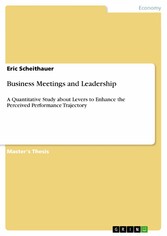Business Meetings and Leadership - A Quantitative Study about Levers to Enhance the Perceived Performance Trajectory
von: Eric Scheithauer
GRIN Verlag , 2018
ISBN: 9783668611504
, 147 Seiten
Format: ePUB, PDF
Kopierschutz: frei
Preis: 36,99 EUR
eBook anfordern 
Mehr zum Inhalt

Business Meetings and Leadership - A Quantitative Study about Levers to Enhance the Perceived Performance Trajectory
Master's Thesis from the year 2017 in the subject Business economics - Business Management, Corporate Governance, grade: 1.0, University of applied sciences Frankfurt a. M., language: English, abstract: Over the last years, the global market environment has rapidly evolved. Disruptive innovations have altered the technological landscape and turned existing business models and ways of operating upside down. In this highly dynamic environment, organizations and leadership face a multitude of different challenges, as new market players have emerged and fierce competition is on the rise. Today, it is crucial to embrace specific organizational skills and behaviors to stay relevant in the future. In a volatile, uncertain, complex and ambiguous (VUCA) business context, these are key to stay competitive and to lay solid foundations for future growth. To facilitate this, organizations have strived to make their processes as efficient and effective as possible. Remarkably, they have yet not unlocked the improvement potential that is associated with business meetings. As a matter of fact, business meetings have not only become an indisputable part of daily business operations all around the world, but also a subject that is often perceived as costly, unproductive and dissatisfying. The purpose of this work is to both advance the current research on business meetings at the intersection with leadership and provide actionable insights for businesses on how to enhance their organizational performance in practice. By using a quantitative study to analyze 301 responses gathered from an online survey and test associated hypotheses, insights about the current state of meeting usage and their implications on organizational performance, based on perceived meeting satisfaction and outcomes, were identified. Essentially, when trying to optimize their performance trajectory, organizations need to focus on a triad of meeting performance, consisting of meeting design, behavior and communication, and meeting technology. If the insights are taken seriously and the suggested solutions are implemented in practice holistically, organizations will have the opportunity to reap the benefits of enhanced performance while cutting costs by around USD 8.5 million annually.












